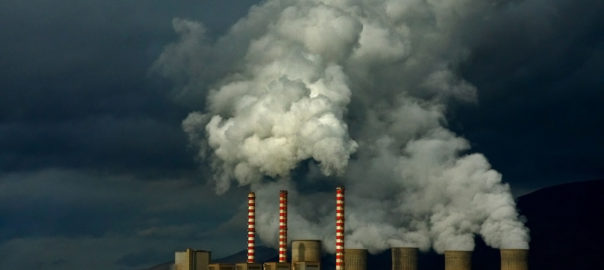By Kent R. Kroeger (July 3, 2018)
With release of GermanWatch.org’s Climate Change Performance Index for 2018, we are starting to better understand the most significant drivers and barriers facing countries trying to address climate change.
Based on an analysis of GermanWatch’s policy and environmental data for 56 countries in 2017, combined with data from Freedom House’s Freedom in the World 2018 Report and the Heritage Foundation’s Index of Economic Freedom, the following conclusions are drawn about the factors driving climate change policy in the world today:
(1) Addressing climate change is still predominately a European-led project.
(2) Countries facing the greatest risks from climate change are less likely to implement strong climate change policies.
(3) Political and social freedom is associated with stronger climate change policies.
(4) However, labor freedom, has a negative impact on climate change policies.
(5) And, finally, economic prosperity (as measured by GDP per capita) is still, all else equal, associated with negative climate policies and outcomes.
This last finding has hampered the climate change policy debate since its inception and still stands as the biggest political barrier facing environmentalists trying to significantly change the world’s energy policies. However, the ground is shifting fast underneath the energy industry such that, within a few years, the ‘coal-is-the-cheapest-energy-source’ argument will be retired permanently.
According to a November 2017 econometric analysis by the energy investment and consulting firm, Lazard LLC, as the “levelized cost of energy(LCOE) values for alternative energy technologies continue to decline, in some scenarios the full-lifecycle costs of building and operating renewables-based projects have dropped below the operating costs alone of conventional generation technologies such as coal or nuclear. This is expected to lead to ongoing and significant deployment of alternative energy capacity.”
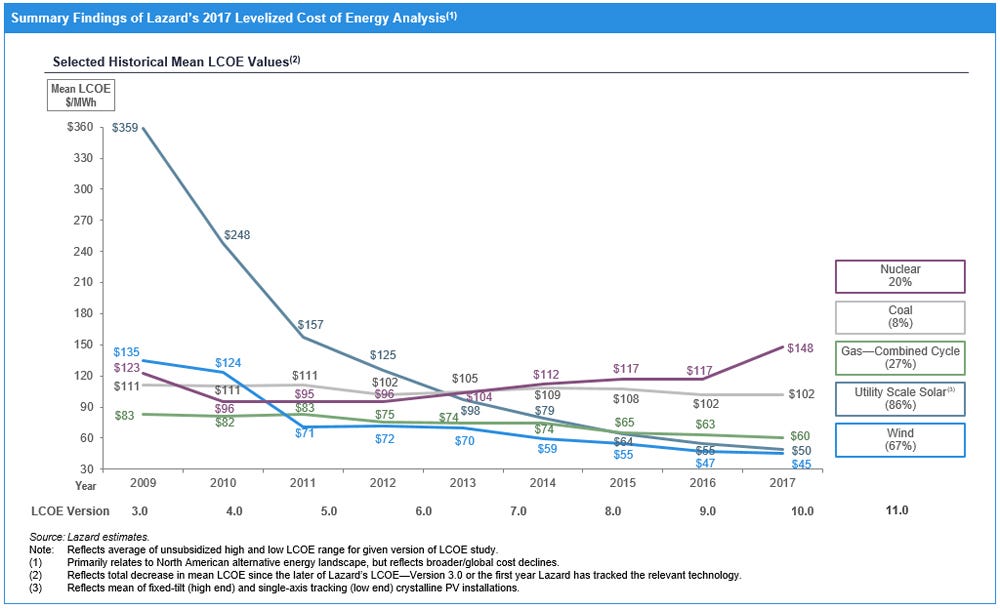
That’s the good news. Here’s the bad…
The Lazard LCOE analysis also reminds us about the remaining disadvantage of renewable energy — it is still an intermittent energy source. It is not always windy and the sun doesn’t always shine. Developed economies, like the U.S. and those in Europe, and fast-developing countries, like China and India, need a lot of energy ALL OF THE TIME and renewable energy sources cannot yet be relied upon to meet base-load electricity generation requirements.
“Although alternative energy is increasingly cost-competitive and storage technology holds great promise, alternative energy systems alone will not be capable of meeting the base-load generation needs of a developed economy for the foreseeable future. Therefore, the optimal solution for many regions of the world is to use complementary conventional and alternative energy resources in a diversified generation fleet,” said the 2017 Lazard report.
The problem with a ‘diversified generation fleet’ is that it creates redundancies in the energy economy. For every solar/wind plant, there must still be an existing coal, natural gas or nuclear plant capable of providing an area’s electricity needs.
This will not always be true. But it is true today and that is why China and India, with rapidly increasing energy needs, are forced to build new coal plants in the near future. Once built, the economics will lean towards seeing those plants stay open for the majority of their 40-year lifespan.
Until battery storage technology becomes affordable and scalable for national needs, climate change policy debates will continue to be driven by old biases and assumptions about ‘cheap coal’ and the economic damage caused by more expensive (and intermittently available) renewable energy sources.
The Stickiness of the Economic Growth-Clean Energy Trade-Off
As the two largest economies (and polluters) in the world — the U.S. and China represent the genuine challenges of pursuing strong economic growth while also converting to a 100%-renewable energy economy.
As mentioned, the cost-efficiency gap is closing between energy production from fossil fuels (coal, oil and gas) and renewables (solar and wind, primarily), and as that continues the growth-vs-green dilemma will fade — though, for countries with substantial domestic and fossil fuel reserves still in the ground or developing countries in the midst of rapid economic growth, this dilemma will not go away as fast as the Paris Agreement requires.
The central dilemma facing negotiators for the 2016 Paris Agreement was accommodating rising economic powers — China, India, and Brazil — who were concerned that overly aggressive climate change policy goals would jeopardize their rapid economic ascension.
As evidenced by Greenpeace’s recent report that China’s greenhouse gas emissions (GHGE) surged during the first quarter of 2018 due to strong growth in the Chinese economy, economic growth and the policy goals adopted in Paris remain at odds in countries like China.
Leading into the 2016 Paris Agreement negotiations, a number of environmental activists, energy sector leaders, and academics met in Paris in May 2015 to review the most recent research on the supposed growth-vs-green trade-off. Their conclusions foreshadowed the findings of the 2017 Lazard LCOE analysis. Economic growth and renewable energy can be complimentary, not contradictory.
If we believe the forecasts regrading the future costs of climate change (e.g., flooding, droughts, fires, etc.), the costs associated with renewable energy’s intermittency dilemma become less problematic.
Nicholas Stern, a world-renowned economist and the IG Patel Professor of Economics and Government at the London School of Economics (LSE), chided the seminar attendees for not being more assertive in debunking the growth-vs-green trade-off: “The alleged trade-off between climate change and economic growth is fake. An artificial horse race. The big issue is political will…that (political) commitment has to spread around the world. We are seeing it change in China and other places, but not yet fast enough.”
But Stern may not be as sufficiently sensitive, as is China’s leadership, to any factor that may slowdown China’s still fast growing economy.
One observer of China’s Communist Party leadership and polices, Ho-Fung Hung, an associate professor of sociology at Johns Hopkins University, warned in 2015 that China’s need for strong economic growth has created a significant debt problem which has, in turn, created an even greater need for fast economic growth. “China’s 2008–09 economic stimulus policies significantly increased China’s debt to GDP ratio from 147 percent in 2008 to 282 percent now (2015), and is still growing,” he wrote in Foreign Policy. “It is at a dangerously high level compared to other emerging economies. The economic slowdown will lead to profit decline for companies and revenue shortfall for local governments, increasing their difficulty in servicing and repaying debts. A vicious cycle of defaults and further growth deceleration could turn a slowdown into something uglier.”
As of today, China’s total debt-to-GDP ratio is at around twice the level it was at the end of 2008 (when excluding financial sector debts) and remains a sticky problem for the Chinese Communist Party (CCP). “That Chinese debt has grown to dangerous levels is beyond dispute,” wrote the editors at the Financial Times in February. However, other observers note that China’s outstanding public sector debt, valued at about $4 trillion, is dwarfed by the assets controlled by all levels of governments in China. In other words, China’s sovereign risk due to high debt is extremely low.
One remedy for China’s growing debt is an even faster growing economy and that is why China’s leadership is unlikely to risk such growth by being too aggressive in converting China’s energy economy from fossil-based to renewable-based.
In time, China will be the world leader in renewable energy. As of today, they can’t afford to be.
Other Factors Impacting the Adoption of Climate Change Policies
Even as the growth-vs-green trade-off argument rapidly becomes obsolete, there other factors just as important working for and against the ability of signatory nations to comply with the Paris Agreement’s aggressive policy goals.
First, converting the world to 100%-renewable energy is still largely a European project. The renewable energy revolution has not been embraced on a global scale yet. GermanWatch’s list of the Top 15 countries on the 2018 Climate Change Performance Index (CCPI) shows evidence of this fact. Thirteen of the Top 15 on the CCPI are European countries.
Top 15 Countries on the Climate Change Performance Index (2018)
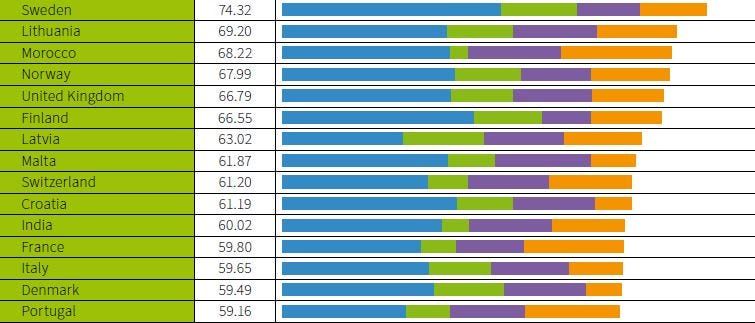
The bottom 10 are even more interesting (in descending order): Canada, Malaysia, Russia, Taiwan, Kazakhstan, U.S., Australia, South Korea, Iran, and Saudi Arabia. Six of these countries are significant oil and gas producers; three are rapidly developing countries; and the apparent outlier is Australia.
Freedom Facilitates Substantive Policies on Climate Change
Using a linear model to explain variation in GermanWatch’s CCPI (see Appendix B for the model’s parameters and diagnostics), four variables (along with an indicator for European nations) proved statistically significant: Political freedom (as measured by Freedom House’s Freedom Index), climate risk exposure (as measured by GermanWatch.org), Labor Freedom (as measured by the Heritage Foundation), and economic prosperity (as measured by GDP per capital, PPP, $USD).
Most encouraging is the apparent importance of political and social freedom in facilitating substantive climate policies and outcomes. As our own president often suggests, dictators and authoritarian regimes are more empowered to implement policy changes than pluralistic democracies where partisan stalemates seem the norm.
In fact, the opposite is true — at least in the case of climate policy.
According to the linear model’s estimates, a 1-unit increase in the Freedom Index (which ranges from 0 to 100) results, on average, in a 0.2-unit increase in the CCPI (which ranges from 0 to 100).
The chart below shows the bivariate relationship between the CCPI and Freedom House’s Freedom Index. The clump of countries in the upper-right-hand corner of the chart are almost all ‘free’ societies (e.g., Sweden, Norway, Finland, France, Germany, UK, etc.). And what countries disproportionately lag on the CCPI? Authoritarian regimes like Russia, Iran, Saudi Arabia, and Kazakhstan.

The finding that democracy and freedom are crucial to meaningful climate policy is reaffirming. Maybe democracy hasn’t lost its relevance. But there is a downside, if you believe meeting the Paris Agreement’s goals are necessary for global survival. Many of the world’s climate laggards (and significant GHC emitters) are either authoritarian (China, Russia, Egypt, Thailand, Iran) or flawed democracies (Malaysia, Turkey, Algeria), making worldwide compliance with the Paris Agreement’s a probable fantasy.
Nonetheless, any effort to promote pluralistic, democratic societies can only help in meeting the goals of the Paris Agreement.
Exposure to Climate Risk Fails to Drive Action on Climate Change
Quite surprisingly, a nation’s exposure to the consequences of climate change (e.g., hurricanes, floods, droughts, fires, etc.) makes the country less likely to adopt progressive climate policies (see chart below). It is important to note that GermanWatch’s Climate Risk Index ranges from 0 to 100 where 0 indicates high exposure to climate change’s consequences and 100 indicates no exposure.

According to the linear model’s estimates, a 1-unit increase in the Climate Risk Index results, on average, in a 0.1-unit increase in the CCPI. Such that, countries such as Finland, Sweden and Norway, who have suffered less from catastrophic climate and weather-related events between 1997 and 2016 are more likely have implemented climate policies aimed at mitigating the economic and social risks of climate change.
In contrast, countries most exposed to weather catastrophes, such as the U.S., Australia and China Taipei (Taiwan), have adopted less aggressive climate policies.
It should be mentioned that GermanWatch’s 57-country sample excludes many countries vulnerable to climate change (Bolivia, Bangladesh, Vietnam, Sri Lanka, most Pacific island countries) and have therefore not received CCPI scores by GermanWatch. As to how their inclusion might change the linear model results reported here, it is pure conjecture on my part, but I believe it is reasonable to assume many of those excluded countries have climate policies towards the lower end of the CCPI scale.
Labor Freedom Dampens Action on Climate Change
Almost as surprising as the relationship between climate risk and the CCPI is the finding that higher levels of labor freedom are associated with lower CCPI scores. The chart below shows the bivariate relationship between the Labor Freedom Index and the CCPI.
According to the linear model’s estimates, a 1-unit increase in the Labor Freedom Index results, on average, in a 0.3-unit decrease in the CCPI.
Heritage Foundation’s Labor Freedom Index is measured using seven quantitative sub-measures: (1) the ratio of minimum wage to the average value added per worker, (2) the level of hindrance to hiring additional workers, (3) the rigidity of workers hours, (4) the difficulty of firing redundant employees, (5) the legally mandated notice period, (6) levels of mandatory severance pay, and (7) the labor force participation rate.
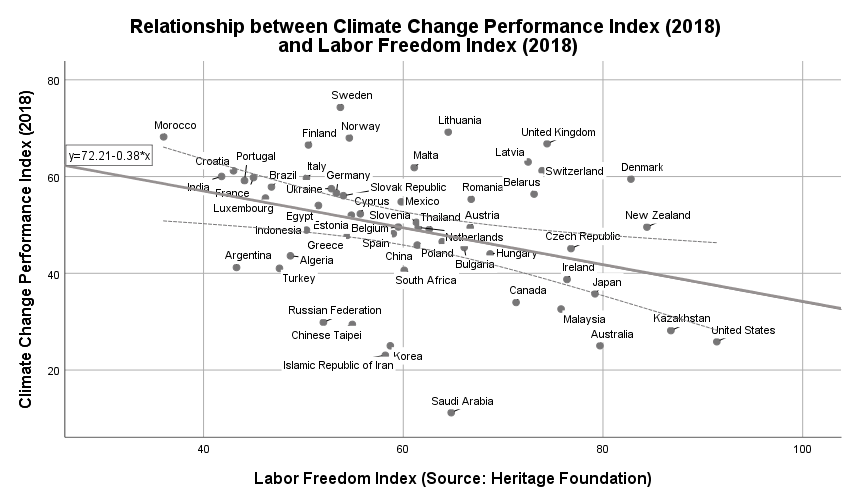
So why would higher levels of labor freedom associate with less aggressive climate policies?
It is conjecture at this point, but to the extent that high values on Heritage’s Labor Freedom Index are related to particularly more labor freedoms for blue collar workers, it is possible such workers in the presence of such freedoms also place a lower priority on climate change policies and are able to influence public policy accordingly.
This is a question to investigate more systematically in the future.
Economic Prosperity and Action on Climate Change Remain in Conflict
As I addressed the growth-vs-green trade-off earlier in this essay, I will note from the chart below that the bivariate relationship between economic prosperity and the CCPI does not visually appear strong. But this cross-sectional analysis tells us little about the dynamic relationship that other research shows exists between economic growth (GDP annualized change) and greenhouse gas emissions.
That such a relationship exists now in some countries (e.g., China) does not mandate that this relationship must continue into the future. Falling costs for large-scale renewable energy generation (as well as the higher penetration of electric cars in the more distant future) will most certainly change the growth-vs-green trade-off.
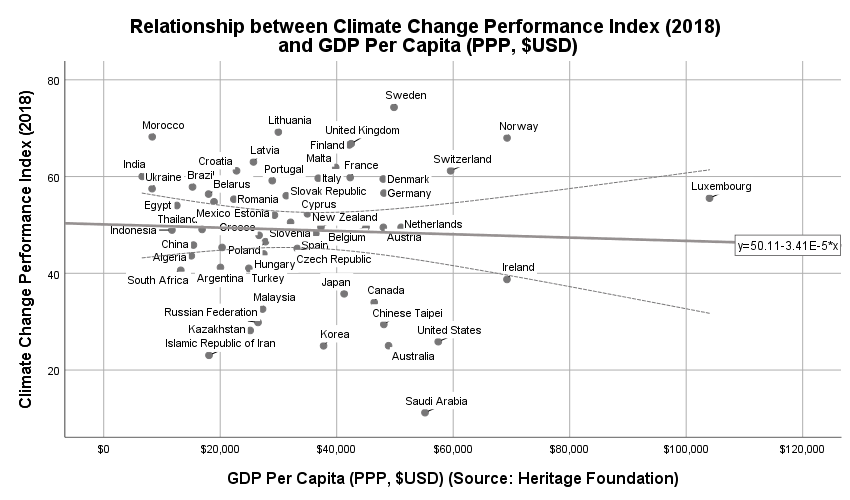
Last thoughts…
For those skeptical that the world is on a path to ‘catastrophic’ levels of warming in the next 80 years, I share some of your skepticism; but, also recognize there are other important reasons — such as environmental damage and economic inequality — to end the world’s addiction to fossil fuels sooner rather than later.
Converting the world’s energy supply to affordable renewable sources is an epic project that will fundamentally change the world’s current distribution of wealth and power.
Which is why I find hyperpartisan climate activists so irritating. Their ‘sky-is-falling’ mantra repeatedly exposes them to legitimate criticism about the accuracy and reliability of climate science’s forecasts for global warming and its associated consequences.
Doomsday predictions about humanity’s fate never materialize.
We have been led us down this path by scientists and policy experts before…
New ice age? Didn’t happen. Over-population leading to hundreds of millions of people dying of starvation by 1980. Didn’t happen. Y2K would lead to mass blackouts and economic chaos. Nope. Didn’t happen either.
The hyperbole surrounding climate change does a disservice to those who want substantive action. Here are just two examples:
In the late 2000s, Al Gore publicly suggested the possibility that Arctic sea ice could be completely gone during the summer by around 2013 or 2014.
In a New York Magazine article, David Wallace-Wells wrote that global warming is advancing so fast that in our children’s lifetime the earth may no longer sustain us. “Most people talk as if Miami and Bangladesh still have a chance of surviving,” wrote Wallace-Wells, “The scientists I spoke with assume we’ll lose them within the century, even if we stop burning fossil fuel in the next decade.
I wish to be around in 2100 to verify if Miami and Bangladesh will still exist. I am confident they will.
Doomsday predictions NEVER come true.
Sure, someday a giant asteroid will hit the earth and do unspeakable damage to those sill living on it. [I’m assuming humans will be clever enough by then to move our species to other places in our galaxy before the asteroid hits.]
If the planet-killing asteroid doesn’t get us, however, the collapse and subsequent expansion of the Sun past earth’s orbit will. I won’t even mention the possibility of a gamma-ray burst wiping us out.
The point is, global warming will not be a human extinction event and our ability to innovate and adapt to environmental changes will limit its most serious life-threatening consequences. Knowing that in no way diminishes the real dangers posed by the human-caused warming of our planet. Even if the actual warming is on the low side of the current predictions, its impact will be profound, particularly among poorer people living in arid regions or along coastal shores.
Which, again, is what makes climate activists so maddening. We do not need to hear one more partisan, cable news pundit with an art history degree lecturing those who are not in a sufficient degree of panic regarding global warming.
It is not just an unwarranted and slavish level of respect for current climate science (which is a relatively young science attempting to understand a complex, non-linear dynamical system), using shaming as a tool for political discourse drives climate realists (like myself) out of the debate. All that remains in the public arena are the most narrow-minded partisans (both left and right) screaming at each other, often over trivial or unprovable points of fact.
The better solution is a polyrationale approach to the climate change discourse. There are many excellent reasons (unrelated to global warming) to push for a rapid transition to renewable energy. Having seen the choking, life-shortening levels of air pollution and environmental damage in Beijing and other major Chinese cities, it is absolutely imperative that China’s (and India’s) inevitable economic rise follow an environmentally sustainable path unlike the one followed by Europe and the U.S.
Even as China is making great strides in reducing air pollution and improving water quality, the possibility that wealthy Chinese will leave China for ‘greener’ pastures elsewhere remains a palpable concern to the CCP.
Another important reason to rapidly transition to renewable energy is facilitating a fairer worldwide distribution of wealth and power (and hopefully fewer ill-fated, budget-crushing regime change wars by the U.S. attempting to control the West’s access to the world’s fossil fuel reserves).
Neither of these rationales require catastrophic predictions about global warming’s impact. Where now climate skeptics can rationalize their dismissive attitude about anthropogenic global warming every time the climate change activists exaggerate and oversell its consequences, under a polyrationale approach, a much broader political consensus is possible.
In other words, as long as the public debate on global warming remains a fundamentally a partisan one, the world’s transition to renewable energy will be slower than necessary.
- K.R.K.
APPENDIX A: Explanation of the Climate Change Performance Index Score (2018)
(From the GermanWatch.org Website)…
The Climate Change Performance Index (CCPI) is an instrument designed to enhance transparency in international climate politics. Its aim is to put political and social pressure on those countries which have, up until now, failed to take ambitious action on climate protection. It also aims to highlight those countries with best practice climate policies.
On the basis of standardized criteria, the index evaluates and compares the climate protection performance of 56 countries and the EU, which are together responsible for more than 90 percent of global greenhouse gas (GHG) emissions.
In 2017 the design of the CCPI was revised, due to recent global climate policy developments in the last years. One of the major events that marked a milestone in the international climate negotiations was the entry into force of the Paris Agreement.
For the first time, it is possible to measure the performance of states based on the promises they themselves formulated in their Nationally Determined Contributions (NDCs). So far 169 Parties have ratified the Paris Agreement and promised to combat dangerous climate change in limiting global temperature rise to well-below-2°C or even 1.5° C.
The CCPI aims to capture the fulfillment of those promises and evaluates the countries’ 2030 targets within the important categories greenhouse gas emissions, renewable energy and energy use to determine, how well they are on track to a well-below-2°C pathway. The CCPI now also reflects countries’ current performances towards this pathway in absolute terms, in addition to the remaining relative indicators measuring the current level and past trends in all three categories. 40% of the evaluation is based on indicators of emissions, 20% on renewable energies and 20% on energy use. The remaining 20% of the CCPI evaluation is based on climate policy assessments by experts from the respective countries. Besides changes in the weighting and smaller modifications within the calculation method, the addition of indicators, which measure the progress of countries on their way not to overshoot the well-below-2°C limit, are the major changes in the new design. The three categories GHG Emissions, Renewable Energy and Energy Use are defined by four indicators each (recent developments, current levels and 2°C compatibility of the current performance as well as an evaluation of the countries’ 2030 targets in the respective categories). With these complements, the CCPI covers the evaluation of the countries promises as well as their current progress in terms of climate protection.
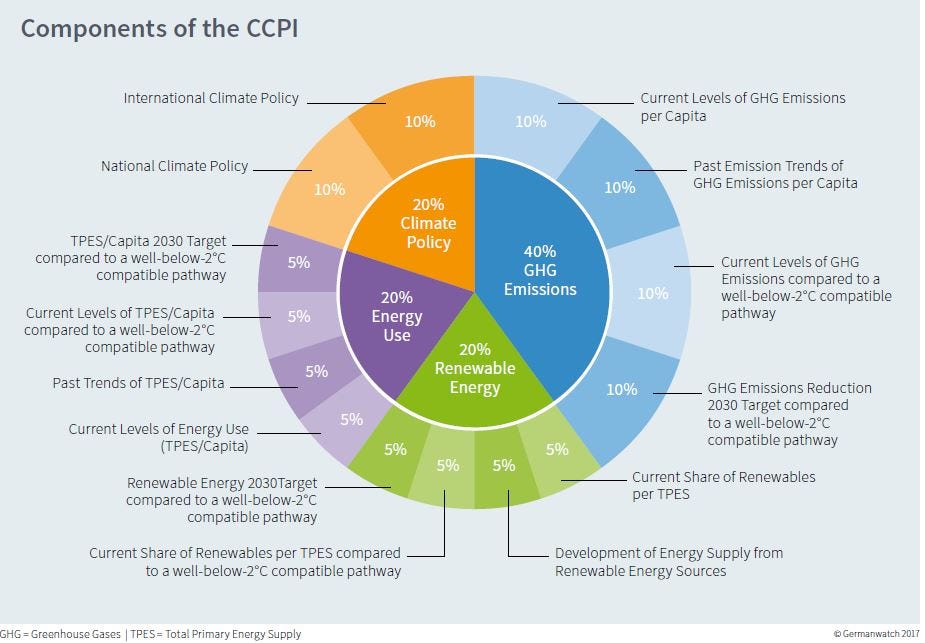
APPENDIX B: Linear Model for Climate Change Performance Index Score (2018)

